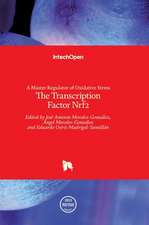Cyanobacteria Biotechnology: Advanced Biotechnology
Autor P Hudsonen Limba Engleză Hardback – 4 mai 2021
Preț: 923.10 lei
Preț vechi: 1198.83 lei
-23% Nou
Puncte Express: 1385
Preț estimativ în valută:
176.68€ • 183.76$ • 148.06£
176.68€ • 183.76$ • 148.06£
Carte disponibilă
Livrare economică 17-24 februarie
Livrare express 06-12 februarie pentru 81.37 lei
Preluare comenzi: 021 569.72.76
Specificații
ISBN-13: 9783527347148
ISBN-10: 3527347143
Pagini: 560
Dimensiuni: 176 x 248 x 32 mm
Greutate: 1.22 kg
Editura: Wiley Vch
Seria Advanced Biotechnology
Locul publicării:Weinheim, Germany
ISBN-10: 3527347143
Pagini: 560
Dimensiuni: 176 x 248 x 32 mm
Greutate: 1.22 kg
Editura: Wiley Vch
Seria Advanced Biotechnology
Locul publicării:Weinheim, Germany
Cuprins
1 Inorganic carbon assimilation in cyanobacteria: mechanisms, regulation and engineering
1.1 Introduction - the need for a carbon-concentrating mechanism
1.2 The carbon-concentrating mechanism (CCM) among cyanobacteria
1.3 Regulation of Ci assimilation
1.4 Engineering the cyanobacterial CCM
1.5 Photorespiration
1.6 Concluding remarks
2 Electron transport inc yanobacteria and its potential in bioproduction
2.1. Introduction
2.2. Electron transport in a bioenergetic membrane
2.3. Respiratory electron transport
2.4 The role of electron sinks in photoprotection
2.5 Regulating electron flux into different pathways
2.6 Spatial organisation of electron transport complexes
2.7 Manipulating electron transport for synthetic biology applications
2.8 Future challenges in cyanobacterial electron transport
3 Optimizing the spectral fit between cyanobacteria and solar radiation in the light of sustainability applications
3.1 Introduction
3.2 The molecular basis and efficiency of Oxygenic Photosynthesis
3.3 Fit between the spectrum of solar radiation and the action spectrum of photosynthesis
3.4 Expansion of the PAR region of Oxygenic Photosynthesis
3.5 Modulation and optimization of the transparency of photobioreactors
3.6 Full control of the light regime: LEDs inside the PBR
3.7 Conclusions and prospects
4 What we can learn from measuring metabolic fluxes in cyanobacteria
4.1 Central carbon metabolism in cyanobacteria: an overview and renewed pathway knowledge
4.2 Methodologies for predicting and quantifying metabolic fluxes in cyanobacteria
4.3 Cyanobacteria fluxome in response to altered nutrient modes and environmental conditions
4.4 Metabolic fluxes redirected in cyanobacteria for biomanufacturing purposes
4.5 Synopsis and future directions
5 Synthetic biology in cyanobacteria and applications for biotechnology
5.1 Getting genes into cyanobacteria
5.2 Basic synthetic control of gene expression in cyanobacteria
5.3 Exotic signals for controlling expression
5.4 Advanced regulation: the near future
5.5 Conclusions
6 Sink Engineering in Photosynthetic Microbes
6.1 Introduction
6.2 Source and Sink
6.3 Regulation of Sink Energy in Plants
6.4 Engineered pathways as sinks in Photosynthetic Microbes
6.5 What are key source/sink regulatory hubs in photosynthetic microbes?
6.6 Concluding Remarks
7 Design principles for engineering metabolic pathways in cyanobacteria
7.1 Introduction
7.2 Cofactor optimization
7.3 Incorporation of thermodynamic driving force into metabolic pathway design
7.4 Development of synthetic pathways for carbon conserving photorespiration and enhanced carbon fixation
7.5 Summary and future perspective on cyanobacterial metabolic engineering
8 Engineering cyanobacteria for efficient photosynthetic production: ethanol case study
8.1 Introduction
8.2 Pathway for ethanol synthesis in cyanobacteria
8.3 Selection of optimal cyanobacteria ?chassis,? strain for ethanol production
8.4 Metabolic engineering strategies toward more efficient and stable ethanol production
8.5 Exploring the response in cyanobacteria to ethanol
8.6 Metabolic engineering strategies to facilitate robust cultivation against biocontaminants
8.7 Conclusions and Perspectives
9 Engineering cyanobacteria as host organisms for production of terpenes and terpenoids
9.1 Terpenoids and industrial applications
9.2 Terpenoid biosynthesis in cyanobacteria
9.3 Natural occurrence and physiological roles of terpenes and terpenoids in cyanobacteria
9.4 Engineering cyanobacteria for terpenoid production
9.5 Summary and outlook
10 Cyanobacterial biopolymers
10.1 Polyhydroxybutryate
10.2. Cyanophycin granules in cyanobacteria
11 Biosynthesis of fatty acid derivatives by cyanobacteria: from basics to biofuel production
11.1 Introduction
11.2 Overview of fatty acid metabolism
11.3 Basic technologies for production of free fatty acids
11.4 Advanced technologies for enhancement of free fatty acid production
11.5 Hydrocarbon production in cyanobacteria
11.6 Advanced technologies for enhancement of hydrocarbon production
11.7 Basic technologies for production of fatty alcohols
11.8 Advanced technologies for enhancement of fatty alcohol production
11.9 Basic technologies for production of fatty acid alkyl esters
11.10 Perspectives
12 Product export in cyanobacteria
12.1 Introduction
12.2 Secretion mediated by membrane-embedded systems
12.3. Membrane vesicle-mediated secretion
12.4 Concluding remarks
13 Harnessing Solar-Powered Oxic N2-fixing Cyanobacteria for the BioNitrogen Economy
13.1 Introduction
13.2 Physiology and Implications of Oxic Nitrogen Fixation
13.3 Major Biotechnology Applications for Diazotrophic Cyanobacteria
13.4 Conclusions
14 Traits of fast-growing cyanobacteria
14.1 Introduction
14.2 Why is growth rate significant?
14.3 An overview of factors affecting growth rates of cyanobacteria
14.4 An overview of the fast-growing model cyanobacteria
14.5 Relationship between light usage and growth rate in model strains
14.6 Molecular determinants of fast growth of S. elongatus UTEX 2973
14.7 Carbon fluxes in fast-growing strains determined using metabolic flux analysis (MFA)
14.8 Engineering cyanobacteria for fast growth
14.9 Conclusion
15 Cyanobacterial biofilms in natural and synthetic environments
15.1 Motivation
15.2 Introduction to biofilms: biology and applications
15.3 Cyanobacteria in natural biofilms and microbial mats
15.4 Introduction to (Photo-)biotechnology
15.5 Benefits of microscale systems for (photo-)biofilm cultivation
15.6 Oxygen accumulation and its impacts
15.7 Resource management in biofilms
15.8 Applications of photosynthetic biofilms
15.9 Outlook
16 Growth of Photosynthetic Microorganisms in Different Photobioreactors Operated Outdoors
16.1 Background
16.2 Case studies of Outdoor Cultivations of Photosynthetic Microorganisms
6.3 Conclusion
























